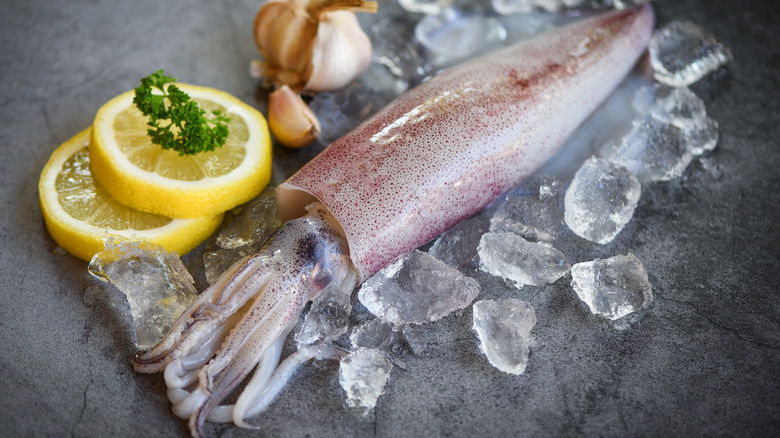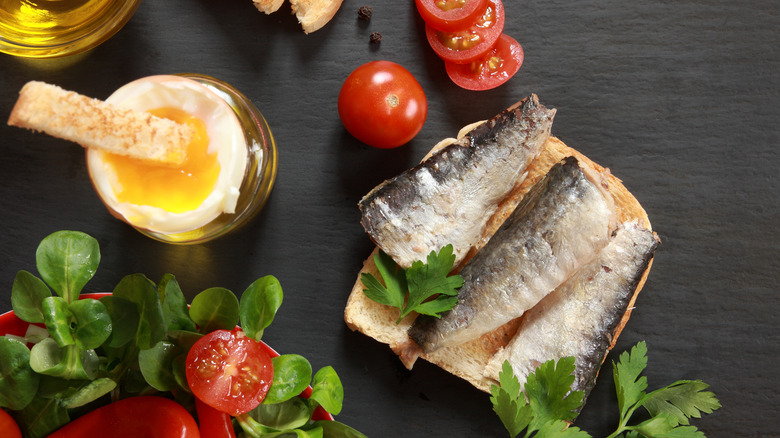Why You May Start Seeing More Squid Served At Restaurants
Restaurants that serve fresh, seafood-to-table dishes routinely change their menus. And there is much to be said about serving seasonal foods. Per Seasonal Food Guide, the food is of better quality when served around the time it is meant to be harvested. In the case of produce, fruits are fresher, vegetables are more nutritious, and eating seasonally helps fishermen stay close to home. This cuts down on transport costs and helps the local economy. In the case of seafood, offering up locally sourced, seasonal seafood is more cost-efficient for restaurants and encourages diners to eat more local fish, which can only be a good thing for the local fishing community, per Nereus Program.
But thanks to climate change, availability doesn't just depend on seasonality anymore. As ocean temperatures rise, marine creatures, from fish to shellfish, are venturing from their traditional habitats to places with cooler temperatures, which determines what fishing fleets can catch, per The Conversation.
Expect menus to feature warm water seafood
Warming waters mean fishing fleets will have to go further to catch what they need, or they'll find marine animals in places they don't expect. Some fishermen tell The New York Times that they are moving north to find fish like capelin, blue whiting, and cod, while others trawling off the eastern coast of the United States "are finding sea bass in Maine and the Spanish hogfish in North Carolina."
As a result, scientists like the University of British Columbia's Professor and Director for the Institute for the Oceans and Fisheries, William W.L. Cheung, say that their menus have been adapting to reflect the type of catch warmer weather dictates for some time now. A study of 362 menus shows that the preferred temperature for seafood served between 1961 to 1990 was 9 degrees Celsius or 48.2 Fahrenheit, but the preferred average temperature for seafood caught and served between 2019 and 2021 is 14 Celcius or 57.2 Fahrenheit, per The Conversation. Cheung explains the link between the catch and what is being served by noting that: "[the] increase in the preferred water temperature of fish on restaurant menus is connected to changes in seawater temperature and the temperature-related changes in the composition of fish species caught during the same period."
As fish search for cooler waters, The Conversation says to expect more dishes with warm water catch like squid and sardines.
Being flexible is imperative marine expert
Chris Voss, president of the Commercial Fishermen of Santa Barbara, tells Eating Well to expect more spiny lobsters because this type of crustacean thrives in warmer waters. Then there are jellyfish, which are widely consumed in Chinese and Japanese restaurants across Asia but aren't widely consumed in America.
Being flexible is imperative if humans are to help marine resources like fish stocks survive climate change. As Eating with the Ecosystem's Kate Masury tells Eating Well, "We can help both our fishing communities and wild populations by going with the flow, eating the species that are available rather than putting pressure on the ones already having a harder time."
To get things going, Voss' organization set up Get Hooked, an initiative that gives subscribers a weekly collection of locally caught, seasonal fish, information about the catch, and recipes that can be used to prepare the seafood. The group's director, Kim Selkoe, said: "The idea is to allow people to feel confident buying fish that they wouldn't know anything about, or that they're not sure they're going to like...As the ocean changes, we want to be the shepherds who make local seafood work and expand people's palates."


